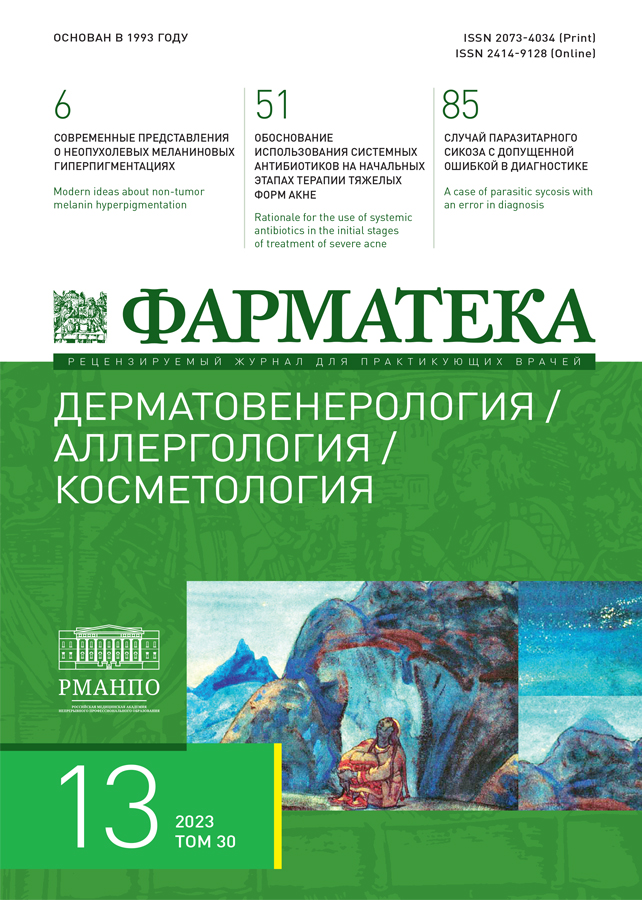Pathomorphological examination of tissues after the combined use of thread lifting and phototherapy
- 作者: Serov D.N.1
-
隶属关系:
- Center for Medical Cosmetology “Aesthetics Group”
- 期: 卷 30, 编号 13 (2023)
- 页面: 37-41
- 栏目: Original articles
- URL: https://journals.eco-vector.com/2073-4034/article/view/625924
- DOI: https://doi.org/10.18565/pharmateca.2023.13.37-41
- ID: 625924
如何引用文章
详细
Background. Thread implantation and phototherapy are the most popular procedures in aesthetic medicine. In the case of complex correction of involutive changes with the sequential use of thread lifting and laser therapy, the interaction of laser radiation and threads in tissues is the relevant issue.
Objective. Pathomorphological study of material taken by biopsy at the sites of thread implantation and the effects of phototherapy 1.5 months after the implantation procedure.
Methods. The work involved a pathomorphological study of material taken using a biopsy at the sites of implantation of threads and surrounding tissues (1 cm indentation) (Nano spring, Excellence Visage, Excellence Visage HA) and the laser therapy procedure (Palomar diode laser, 1540 nm, Lux DeepIR attachment, parameters 80:4:4, 3 passes). Paraffin sections 5–7 µm thick were prepared from ready-made paraffin blocks and stained with hematoxylin-eosin according to the Weigert–Van Gieson method, Sirius Red staining. Using a microscope with a Sony digital photo attachment with 12 megapixel resolution, 5 photographs were taken from each histological specimen. A total of 2,906 microphotographs were examined.
Results. The threads were implanted into the subcutaneous fatty tissue. In one fragment, the thread was surrounded by bundles of collagen fibers, with a weakly expressed cellular reaction. In other fragments (after exposure to phototherapy), the threads were surrounded by a thicker layer of collagen fibers and had a more pronounced cellular reaction, represented by leukocytes, macrophages, and eosinophils. The bloodstream in the dermis had a “dense” arrangement.
Conclusion. Consistent exposure using phototechnology does not cause complications and allows to enhance the effectiveness of thread lifting.
全文:
作者简介
D. Serov
Center for Medical Cosmetology “Aesthetics Group”
编辑信件的主要联系方式.
Email: pharmateca@yandex.ru
Cand. Sci. (Med), Chief Physician
俄罗斯联邦, Khimki参考
- Santorelli A., et al. Mid-face reshaping using threads with bidirectional convergent barbs: A retrospective study. J Cosmet Dermatol. 2021;20(6):159–57. doi: 10.1111/jocd.14038.
- Khan G., et al. Combined press cog type and cog PDO threads in comparison with the cog PDO threads in facial rejuvenation. J Cosmet Dermatol. 2021;20(10):3294–98. doi: 10.1111/jocd.14092.
- Wong V. The science of absorbable poly (L-lactide-co-ε-caprolactone) threads for soft tissue repositioning of the face: an evidence-based evaluation of their physical properties and clinical application. Clin Cosmet Investig Dermatol. 2021;45–54. doi: 10.2147/CCID.S274160.
- Груздев Д.А., Кодяков А.А., Федоров П.Г. Новый подход к классификации нитей, применяемых для омоложения кожи лица и шеи. Вестник эстетической медицины. 2014;13(2):8–13. [Gruzdev D.A., Kodyakov A.A., Fedorov P.G. A new approach to the classification of threads used for rejuvenating the skin of the face and neck. Bulletin of aesthetic medicine. 2014; 13(2):8–13. (In Russ.)]. doi: 10.12737/5011.
补充文件










